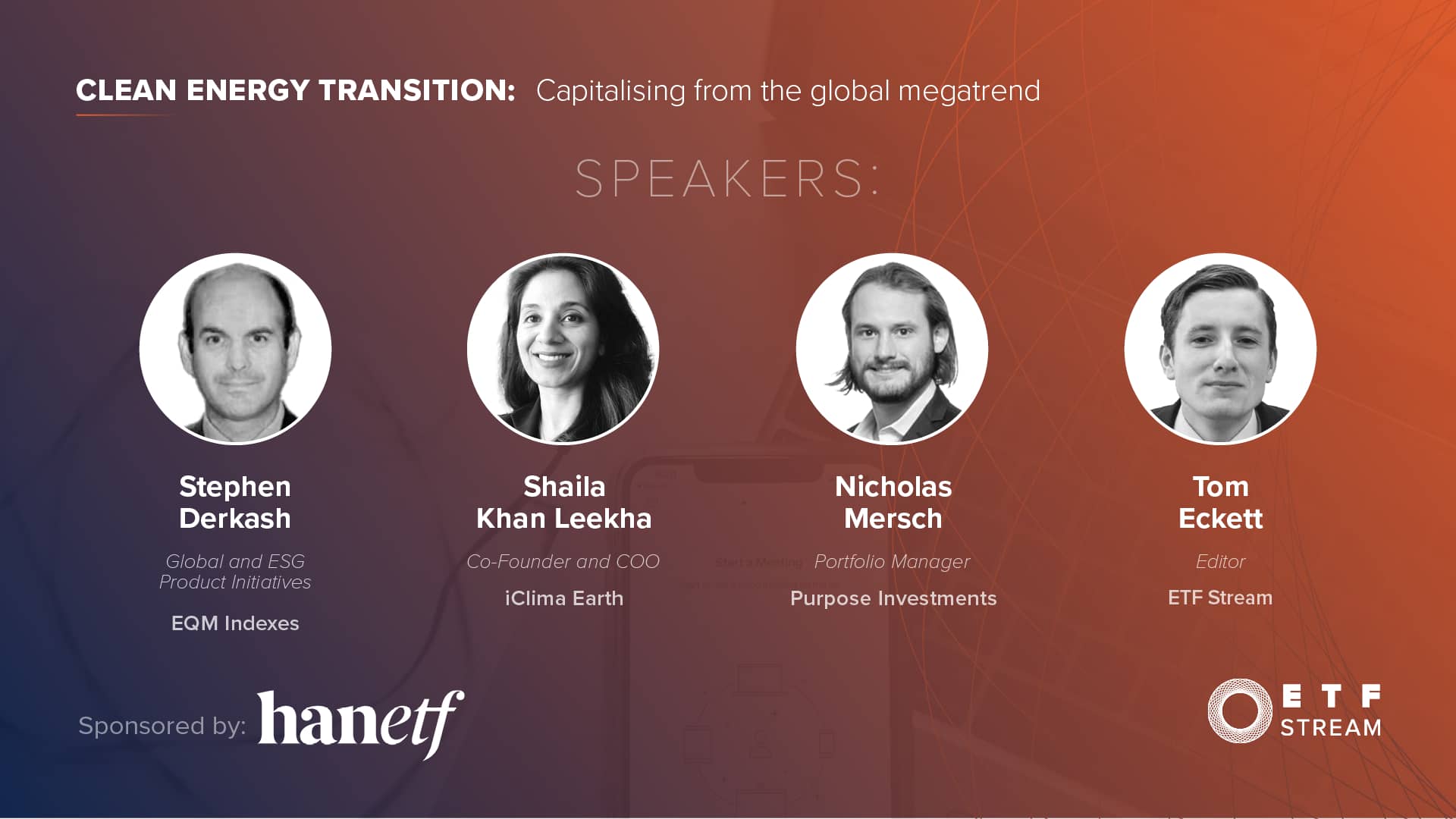The rapid implementation of clean energy utilities, the economics of renewable energy, the challenges of energy supply and necessary evils were all discussed at ETF Stream’s webinar on clean energy.
The webinar, titled Clean energy transition: Capitalising from the global megatrend, started by looking at the pick-up in adoption of clean energy in recent years.
Stephen Derkash, global and ESG product initiatives at EQM Indexes, said in 2018, 26.2% of global electricity generation came from renewable energy, however, added this is forecasted to shoot up to 40% by 2050.
“The clean energy space is at an inflection point, catalysed by initiatives by over 100 countries and many corporations to get to net zero,” Derkash continued.“When you get the confluence of policy and cost, this is what has driven clean energy adoption.”
Shaila Khan Leekha, co-founder and COO of iClima Earth, added 65% of economies now have net zero commitments and 80% of new energy installations are now clean energy-based.
To watch the full webinar, click here.
The economics of going green
Typically waved away by sceptics for being unaffordable or unrealistic, the clean energy industry has enjoyed a decade of unprecedented technological innovation, favourable market forces and ultimately, cost efficiencies.
Derkash, whose company launched Europe’s first solar ETF, The Solar Energy UCITS ETF (TANN), said the price of solar modules made this form of energy among the most expensive in the world 10 years ago.
Now, in many countries solar energy is the cheapest form of new-build energy in the world, with the average price of solar modules already having fallen 99.6% between 1976 and 2019.
Leekha explained this favourable trend in solar power’s unit economics by referring to Swanson’s Law, which posits the price of solar photovoltaic (PV) modules tends to drop 20% every time the sum of panels shipped doubles.
This has been enabled, Derkash said, by the “aggressive” expansion in institutional and residential demand for solar energy; the trajectory of which could see it produce 40% of the UK’s electricity by 2035, up from 4% in 2021, according to the Energy Department.
Decentralised power
A key part of this, Leekha noted, is the role distributed energy will play not just in increasing the capacity of renewable power but shoring up potential gaps in supply from centralised power grids.
Leekha’s firm launched Europe’s first ETF targeting this niche in June, the iClima Distributed Renewable Energy UCITS ETF (DGEN), which offers exposure to sources of local electricity generation and storage, including residential solar, electric vehicle charging, smart inverters and smart meters.
Overall, she said iClima believes the ongoing electrification and digitisation of power generation, storage and metering could see $846bn of investment poured into distributed energy subindustries between 2020 and 2030.
A pragmatic transition
However, despite the large number of positive signals for the clean energy sector, Nicholas Mersch, portfolio manager at Purpose Investments warned viewers that compromise and “necessary evils” would be needed as part of the transition away from fossil fuels.
“The most important part of the next five years is the transition period,” Mersch said. “We cannot come off fossil fuels cold turkey.”
A first measure he supported was relying more heavily on sources such as natural gas.
“Natural gas is a very underappreciated market right now. If all coal production and usage was replaced by natural gas, we would have already met the goals of the Paris accords,” Mersch continued.
Second, he pointed to the uncomfortable alliance between green investors and the resource extraction and manufacturing processes required to make their renewable energy ambitions a reality.
Just for the expansion of electric vehicle manufacturing alone, supply of copper, lithium, cobalt, nickel and more will have to increase exponentially. Also, in all areas of renewable power, including wiring and the hardware or infrastructure itself, metal security in copper and steel will also become increasingly important.
On these issues, Mersch said more needs to be done to green mining processes, which are water-intensive and high-emitting with pollutants such as sulphur dioxide.
Finally, another element in the carbon transition is the role of carbon offsets. Mersch’s firm launched Europe’s first carbon-offset ETF, the HANetf S&P Global Clean Energy Select HANzero UCITS ETF (ZERO), which utilises voluntary offsets purchased from the provider, South Pole, to offset the emissions of investments in its clean energy exposure.
Mersch said: “In terms of secular growth, there are very few areas of the market with these kinds of tailwinds behind them.”
He warned investors need to remain aware of valuations. While the “hype cycle” that occurred during the turn of the year was followed by a correction, Mersch said valuations were now at a more acceptable level.






